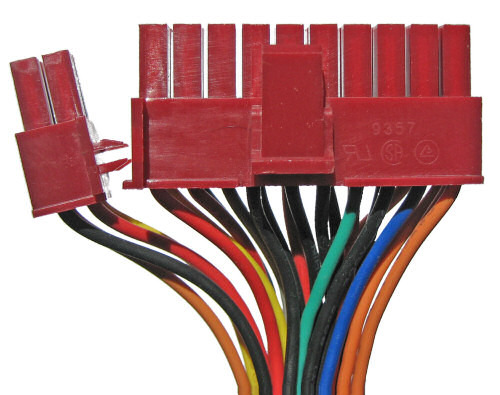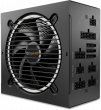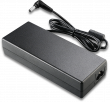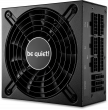Hydro G 750W Semi-Fanless Modular PSU, 80+ Gold Discontinued | |
Hydro G 650W Semi-Fanless Modular PSU, 80+ Gold Discontinued | |
| More variations available Show | |
FSP Hydro G Semi-Fanless Modular PSUs
FSP’s Hydro G PSUs feature a semi-fanless design to help keep noise to a minimum. They are all 80PLUS GOLD certified and are SLI and Crossfire ready.
Features
- Semi-fanless design for silent operation
- Full Japan-made electrolytic capacitors
- Powerful single +12V rail design
- SLI and Crossfire ready
- 80PLUS gold certification
- Full protections: OCP, OVP, SCP, OPP, UVP, OTP
FSP Hydro G series stands for the needs of PC DIY enthusiasts and gamers who want a high end PSU with stylish ID design but do not want to compromise electronic performance at all. By server grade circuit and advanced thermal layout design, Hydro G series deliver full load at 50°C ambient temperature. Silent operation is achievable by an intelligent fan speed control circuit design with 0dBA function to maintain a quiet environment.
Modular design and customisable options
FSP Hydro PSUs are 100% modular which allows customer to use only the cables required to power all installed components. This not only makes the install clean and tidy but also helps to increase system airflow which could be blocked with used non-modular cables. FAP have also made it possible to customise the PSU with alternative stickers of the side of the PSU. If you are interested in making the PSU match the internal colour scheme of the system then two red and green theme stickers are available to allow for this.
High quality Japanese capacitors
FSP have chosen to utilise Japanese capacitors. The main reason for this is to give the PSU longevity and reliability as Japanese capacitors are renowned for being the best available.
FSP have also introduced a new heat dissipation design that conducts heat through a thermal pad on the bottom of the power supply which transforms the whole PSU casing into a heat-sink.
Noise Levels
The chart to the left shows the respective noise level depending on the load of the PSU. As you can see anything below a 25% load will stop the fan from spinning meaning the PSU will be 100% silent which is excellent news for customers wanting the quietest option. When the load increases so does the fan speed. The PSUs are designed to stay at a low noise level for loads under 50%. If the fan remains below 1000 RPM then we would consider it to be extremely quiet.
Plethora of cabling options
All power cables supplied with the Hydro G power supply are of the “ribbon cable” design. This makes the installation extremely tidy and easy to work with. Gamers will be happy to note that PCIe connectors for multiple graphics cards are available. 650W version can accommodate two graphics, while the 750 and 850W PSUs support up to three graphics. Numerous SATA and Molex power connectors are also available. See the specifications cable below for exact details.
| Specifications | Hydro G 650W | Hydro G 750W |
|---|---|---|
| Model | HG650 | HG750 |
| Efficiency | 90% | 90% |
| 80PLUS Certification | GOLD | GOLD |
| Input Voltage | 100 ~ 240Vac | 100 ~ 240Vac |
| Input Current | 8.5A | 10A |
| Frequency | 50 - 60Hz | 50 - 60Hz |
| DC Output +3.3V | 25A | 25A |
| DC Output +5V | 25A | 25A |
| DC Output +12V | 54A | 62.5A |
| DC Output -12V | 0.5A | 0.5A |
| DC Output +5Vsb | 3.5A | 3.5A |
| Combined +3.3V and +5V | 150W | 150W |
| Total Power | 650W | 750W |
| PFC | Active PFC (0.99) | Active PFC (0.99) |
| Over-Current Protection | Yes | Yes |
| Over-Voltage Protection | Yes | Yes |
| Short-Circuit Protection | Yes | Yes |
| Over-Power Protection | Yes | Yes |
| Under-Voltage Protection | Yes | Yes |
| Over-Temperature Protection | Yes | Yes |
| Case Color | Black | Black |
| Chassis Fan | FDB Fan, 135mm | FDB Fan, 135mm |
| Noise | 15 dBA at 50% loading | 15 dBA at 50% loading |
| Form Factor | ATX 12V V2.4 & EPS 12V V2.92 | ATX 12V V2.4 & EPS 12V V2.92 |
| Safety Approval | CE, CB, TUV, C-tick | CE, CB, TUV, C-tick |
| ATX12V 20+4pin | 1 | 1 |
| CPU 4+4pin | 1 | 1 |
| PCI-E 2.0 6+2pin | 4 | 4 |
| S-ATA | 10 | 12 |
| Molex 4pin | 5 | 6 |
| Floppy 4pin | 1 | 2 |
| Dimensions (LxWxH) mm | 150 x 170 x 86 | 150 x 170 x 86 |
| Warranty | 60 months | 60 months |
| EAN barcode | 4711140489704 | 4711140489698 |
| Specifications | Hydro G 650W | Hydro G 750W |
|---|---|---|
| Model | HG650 | HG750 |
| Efficiency | 90% | |
| 80PLUS Certification | GOLD | |
| Input Voltage | 100 ~ 240Vac | |
| Input Current | 8.5A | 10A |
| Frequency | 50 - 60Hz | |
| DC Output +3.3V | 25A | |
| DC Output +5V | 25A | |
| DC Output +12V | 54A | 62.5A |
| DC Output -12V | 0.5A | |
| DC Output +5Vsb | 3.5A | |
| Combined +3.3V and +5V | 150W | |
| Total Power | 650W | 750W |
| PFC | Active PFC (0.99) | |
| Over-Current Protection | Yes | |
| Over-Voltage Protection | Yes | |
| Short-Circuit Protection | Yes | |
| Over-Power Protection | Yes | |
| Under-Voltage Protection | Yes | |
| Over-Temperature Protection | Yes | |
| Case Color | Black | |
| Chassis Fan | FDB Fan, 135mm | |
| Noise | 15 dBA at 50% loading | |
| Form Factor | ATX 12V V2.4 & EPS 12V V2.92 | |
| Safety Approval | CE, CB, TUV, C-tick | |
| ATX12V 20+4pin | 1 | |
| CPU 4+4pin | 1 | |
| PCI-E 2.0 6+2pin | 4 | |
| S-ATA | 10 | 12 |
| Molex 4pin | 5 | 6 |
| Floppy 4pin | 1 | 2 |
| Dimensions (LxWxH) mm | 150 x 170 x 86 | |
| Warranty | 60 months | |
| EAN barcode | 4711140489704 | 4711140489698 |
Customer Reviews
We haven't received any reviews of this product yet.
Whisper quiet and high quality.
I can’t hear any noise from this unit most of the time, fan seems to only occasionally turn on (by design). The cables are high quality and nice to work with, and the PSU being modular helps a lot with cable management/airflow.
I received amazing service from Quiet PC, very fast one day delivery and prompt replies to my questions, highly recommended.
A 5-star PSU, but it came with an EU mains lead!
As a PSU it seems to be brilliant. It replaced an Elan Vital 400W and it’s not a very power-hungry PC, so even at 100% CPU load the fan isn’t running (or is running too slowly to hear) and the case is cool. A big improvement.
It doesn’t matter to me that I now have yet another EU-style mains lead to join the pile, since I already had a UK lead on the PC. Anyone fitting it to a new PSU might get stuck without a lead, though.
Excellent service as usual
Ordered Monday morning, delivered Tuesday lunchtime; excellent service as usual. This was ordered to replace an ageing Zalman power supply that was getting a bit noisy. After replacing the power supply my server is now as near silent as can be with only a faint hum of the disks rotating. I now just need to save up and replace the disks with SSD’s for a completely silent server.
Product Resources
FAQ
Do high wattage power supplies cost more to run?
No - the rated wattage of a power supply refers to the maximum amount of power it can deliver at full load, not how much power it uses. More powerful PSUs will consume around the same amount of power as lower powered power supplies in any given PC system, so your electricity bill will not be higher when using a more powerful power supply!
The best way to reduce your electricity bill when using your PC is to use a more efficient power supply or make your PC consume less power by removing components which are not needed, such as extra drives and expansion cards, or by choosing a cooler-running processor or graphics card.
My brand new power supply doesn’t work! Am I doing something wrong?
It’s possible that the power supply may be faulty, but here are some simple things to check. Firstly, a power supply will not work if you simply plug it in and flick the switch. The power supply will only turn on if you connect it to a working motherboard and associated items (processor, memory, video card, etc). It is actually the motherboard which tells the power supply when to switch on.
Secondly (if applicable), check the voltage is set correctly to 115/230 volts depending on what country you are in. Thirdly, if possible it would be good to try the power supply in another PC to see if it works, or try another power supply in your PC to see if that works. You can then tell whether it is the power supply which is faulty or the actual PC itself. If all else fails, please contact us for further support, and/or return details.
Why should I buy a whole new PSU when I could just replace the noisy fan in my existing one?
Virtually all the noise generated by a PC power supply originates from the cooling fan inside it, so simply replacing the fan with a quiet fan may seem an obvious way to go. However, if you are thinking about attempting this operation, please bear the following points in mind:
- Your existing power supply will be designed to run with a specific amount of airflow in order to adequately cool the components inside and reducing the airflow may lead to overheating and damage to the power supply and/or PC.
- All PC power supplies contain very high voltages and even with the power disconnected, the voltages stored in the capacitors can be easily enough to kill. It is not recommended to take the cover off any PC power supply for this reason unless you are absolutely confident of your own ability. Because of the grave dangers involved, all PC power supplies by law carry a warning label forbidding removal of the power supply case.
- There will be no standard PC fan connector inside the power supply to use to connect a replacement fan, and it would probably have to be soldered directly into the PCB inside the power supply, or have a specialist power connector attached. This can be a tricky operation to say the least.
Please consider the above points very carefully before proceeding with an operation to replace the fan in your existing power supply!
What is PFC (Power Factor Correction)?
If you are interested in being “green” and saving the planet, you might like to read a short explanation of how our power supplies can save energy using Active PFC (Power Factor Correction), not to be confused with Power Conversion Efficiency which is also very good in most of our PSUs. “Power Factor” is a measure of how efficiently electrical power is consumed. Ideally, Power Factor would be 1 (or 100%) and known as unity.
Unfortunately in the real world, Power Factor is reduced by highly inductive loads down to values of 0.7 (70%) or less. This induction is caused by equipment such as small electric motors, fans, fluorescent lighting ballasts and transformers such as those in PSUs. This is bad news for the electricity generating companies who can impose a surcharge on heavy users if they have a consistently low Power Factor, as more electricity has to be produced to make up the shortfall.
Power Factor Correction (PFC) is used in some equipment to minimise the inductive component of the electrical current. This helps to reduce the losses in the electrical supply to that equipment. Power Factor Correction capacitors are normally used to reduce induction in an electrical load, which minimises wasted energy and hence improves the efficiency of a company and reduces electricity costs.
It is not usually practical to reach unity, i.e. Power Factor 1, and it seems that most electricity supply companies accept consumers having a Power Factor as low as 0.94 (94%) without imposing a surcharge. Unfortunately most of the cheap (and not so cheerful) PSUs tend to have a Passive PF as low as 0.75 or 75% which in a large office can lead to a PF surcharge.
However, the good news is that most of Quiet PC’s PSUs implement a system known as Active PFC which involves some clever electronics. This means that their power factor (PF) can be as high as 0.94 or 94% (at full load), while harmful harmonic frequencies are reduced to well below legal requirements. So by using our products, you can be happy in the knowledge that you are doing your bit to save the planet!
How do I know what size of wattage power supply I need?
The best answer we can give to this question is to go ahead and take an intelligent “guesstimate”! There are no hard and fast rules about what size of power supply any given PC needs as a minimum. Our advice would be that if you are replacing an existing power supply, then consider a new one at least of the same wattage as the old one. In addition, if you wish to build in a “safety margin” to allow for reliable running and possible future upgrades, consider adding 100-200 watts to the rating of your existing unit.
If you are building a new PC, most customers now buy a power supply rated in the region of 500-800 watts depending primarily on the performance level of their graphics card(s) and number of drives to be installed. But in any event if you are unsure about which power supply would be best for your PC then please do contact us by phone or email and we will be happy to give you a specific recommendation based on your budget.
My new PSU came with a 24-pin connector but my motherboard needs 20 pins! Do I need an adaptor cable?
We receive many customer enquiries about this. In fact, most of the 24-pin compatible power supplies we sell come with special motherboard connectors which can be converted to 20-pins with no additional conversion cables. All you need to do is look carefully at the connector and you will see that the end four pins can be slid off, turning the connector into a 20-pin compatible one (see below) - easy when you know how!

Image showing how to change a power supply’s 24-pin motherboard connector into a 20-pin connector by unclipping the end four-pin blockWhat do the PSU safety protection abbreviations mean?
There are many possible safety protections a PSU can have. Below is a list of what each abbreviation means. Please note, not all PSUs have all safety protections.
- OCP - Over-Current Protection
- OVP - Over Voltage Protection
- UVP - Under Voltage Protection
- SCP - Short Circuit Protection
- OPP - Over Power Protection
- OTP - Over Temperature Protection
- UL - Underwriters Laboratories, more information.
- TÜV - Technical Inspection Association, more information.
- CE - European Conformity, more information.
- FCC - Federal Communications Commission, more information.
- RoHS - Restriction of Hazardous Substances Directive, more information.
- WEE - Electronic waste, more information.
- 80 PLUS - Promotes energy efficiency for PC power supplies, more information.
- ErP - Energy Related Products, more information.
More information on certification marks can be found here.
Top Quiet Power Supplies

Seasonic PRIME TX-1600 Noctua Edition 1600W 80Plus Titanium Semi-Fanless PSU

Seasonic PRIME Fanless 500W 80PLUS Platinum Modular Power Supply

Streacom ST-NANO160 160W nanoPSU and AC/DC adapter block

Streacom ST-ZF240 ZeroFlex 240W Passive PSU

Seasonic PRIME Fanless 700W 80PLUS Titanium Modular Power Supply

be quiet Pure Power 12 M 750W 80+ Gold Fully Modular ATX3.0 PSU

be quiet Pure Power 11 400W Quiet PSU 80PLUS Gold

FSP Hydro Ti Pro 1000W 80PLUS Titanium Fully Modular ATX 3.0 PSU

Akasa 120W Thin mini-ITX power adapter, AK-PD120-04M

be quiet 600W SFX-L Modular 80PLUS Gold PSU






